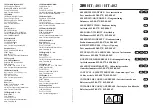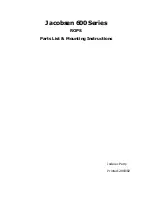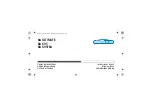
Datacolor Conditioner Operation Manual / DCCOPMN_RP1 / Rev 3.0 / 7th August 07
page 22 of 51
In order to guarantee perfect humidifying, observe the following points with regard to
the water which is used in the water tank:
•
Water type: Tap water with conductivity of 200 µS/cm to 500 µS/cm (tolerance range
100 µS/cm to 800 µS/cm).
Test: Let boil at least 1 litre of tap water in a suitable pot for 10 minutes in order to
precipitate the temporary hardness; then measure the conductivity in the upper half of the
volume.
If the conductivity is between 100 µS/cm and 200 µS/cm large electrodes (DC-5005-0056)
have to be installed.
If the conductivity is between 500 µS/cm and 800 µS/cm an electrode separating plate (DC-
6002-0088) has to be installed between the small electrodes.
If the conductivity is outside of the range of 100 µS/cm to 800 µS/cm contact your local
Datacolor service representative.
•
Total hardness 28.4 mg Ca/l up to 56.8 mg Ca/l.
In this range of hardness the conductivity is normally between 200 µS/cm and 500 µS/cm.
In cases of lower hardness the conductivity is normally too low. In cases of higher hardness
the conductivity may be too high. Furthermore the steam generator calcifies faster and
shorter service intervals are necessary.
But in all cases the conductivity has to be measured as described before. It is possible that
the conductivity is in the range of 200 µS/cm and 500 µS/cm and the unit can be operated
although the hardness differs.
•
Amount of chloride in the water: <100 mg/l
High amounts of chloride and free chlorine, e.g. from water disinfection, causes strong
abrasion of the electrodes.
•
Do NOT use softened water (soft water, distilled water, fully desalted water).
•
The water intake temperature must lie between 5 °C and 60 °C
•
For the connecting the water tank, fix the hose on the hose nozzle of the freshwater
connection (H) at the rear of the chamber.
•
Protect the hose connections at both sides by the delivered hose clamps.
•
If the conductivity of the water is too low (less than 100 µS/cm when using with large
electrodes, the water can be treated to increase the conductivity, by adding quantities of
Sodium- or Potassium-Sulphate (Na
2
SO
4
or K
2
SO
4
) into the tank until the conductivity is
between 300 and 500 µS/cm is reached. Use the standard small electrodes in this case.
Note, do NOT use standard salt (NaCl), as this causes accelerated wear of the electrodes
because of the free Chlorides.
The waste water drainage can be done as described in chap. 4.4 by connecting the waste water outlet to
a siphon of a drain or it can be passed into a 10 l waste water container placed under the waste water
connection. In any case the drain must be lead descending.
















































